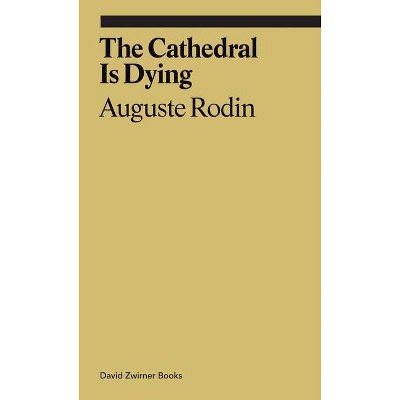The Cathedral Is Dying - (Ekphrasis) by Auguste Rodin (Paperback)

Product info
<p/><br></br><p><b> Book Synopsis </b></p></br></br><b>Master sculptor Auguste Rodin's illuminating writings on cathedrals in France are especially relevant and significant following the recent fire at Notre Dame. </b> <p/>In this volume, the writer and Rodin scholar Rachel Corbett selects excerpts from the famous sculptor's book <i>Cathedrals of France</i>, first published in 1914, just before the outbreak of World War I. Cathedrals were central to the way Rodin thought about his art: he saw them as visual metaphors for the human figure, among the finest examples of craftsmanship known to modern man, and as a model for how to live and work--slowly, brick by brick. <p/> Here, Corbett takes the fire at Notre Dame and the concerns over its restoration as an entry point in an exploration of Rodin's cathedrals. Rodin adamantly opposed restoration, as he felt it often did more damage than the original injury. (Many of the cathedrals that Rodin looks at in his texts were, in fact, bombed during the war.) But while he rails against various restoration efforts as evidence that "we are letting our cathedrals die," the book, with its tenderly rendered sketches and written portraits, is itself an attempt to preserve these cathedrals. The selection of texts in this volume is a reminder--as is the tragedy of Notre Dame--of why we ought to appreciate these feats of architecture, whether or not they are still standing today.<p/><br></br><p><b> Review Quotes </b></p></br></br><br><b>Recent Press on Rachel Corbett: </b> <p/>"This empathetic and imaginative biography, deeply researched, is anchored by the friendship between [Rilke and Rodin]."-- "The New Yorker"<br><br>"In honeyed, knowing prose, Rachel Corbett twines two great serpents of art: the suppleness of Rodin's malleable flesh and eroticism and Rilke's endless lyrical rivers. New portals of aesthetic intonations open; invisible elements come into sight."--Jerry Saltz "New York Magazine"<br><br>"Rachel Corbett, as any fine artist, has produced a work of great effect, and leaves a lasting and indelible mark on the reader."-- "NPR"<br><br>"Takes readers deep into the literary and art worlds of the beginning of the 20th century. . . . A must-read."--Alanna Martinez "Observer"<br><p/><br></br><p><b> About the Author </b></p></br></br><b>Auguste Rodin</b> (1840-1917) is known for an innovative sculptural style in which the traces of his working process are conserved in their works' final form. His career began in Brussels and only later shifted to Paris, where he undertook public commissions that dovetailed with academic trends affirming clarity in sculptural language. These afforded him the support to pursue bolder aesthetic experimentation in private. Rodin's attention to partial figures and fragmentation and his privileging of emotive pathos over allegory are hallmarks of his groundbreaking and influential style. <p/> <b>Rachel Corbett</b> is the author of <i>You Must Change Your Life: The Story of Rainer Maria Rilke and Auguste Rodin</i>, which won the 2016 Marfield Prize, the National Award for Arts Writing. Her essays and journalism have appeared in the <i>New Yorker</i>, <i>The New York Times Magazine</i>, <i>The Atlantic</i>, <i>New York Magazine</i>, and other publications. She wrote the introduction to Rainer Maria Rilke's <i>Letters to a Young Painter</i> (2017), published by David Zwirner Books. <p/> <b>Elisabeth Chase Geissbuhler</b> was twenty years old when she moved to Paris from Boston to study sculpture under Antoine Bourdelle. Bourdelle, who was fond of Elisabeth, had been Rodin's close friend and collaborator. When Geissbuhler translated Rodin's Cathedrals of France in 1965, she was already a recognized Rodin scholar. She continued her exploration of Rodin and his philosophical and artistic influences until her death in 2001.
Price History
Price Archive shows prices from various stores, lets you see history and find the cheapest. There is no actual sale on the website. For all support, inquiry and suggestion messagescommunication@pricearchive.us